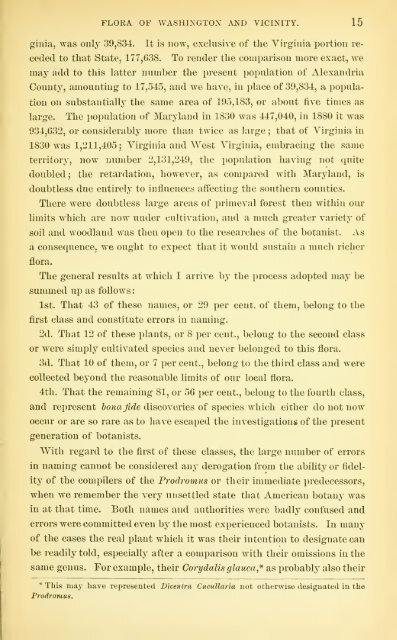Bulletin - United States National Museum - Smithsonian Institution
Bulletin - United States National Museum - Smithsonian Institution
Bulletin - United States National Museum - Smithsonian Institution
Create successful ePaper yourself
Turn your PDF publications into a flip-book with our unique Google optimized e-Paper software.
FLORA OF WASHINGTON' AND VICINITY. 15<br />
giiiia, was only 39,834. It is now, exclusive of the Virginia portion re-<br />
ceded to that State, 177,638. To render the comparison more exact, we<br />
may add to this latter number the present population of Alexandria<br />
County, amounting to 17,545, and we have, in place of 39,834, a popula-<br />
tion on substantially the same area of 195,183, or about five times as<br />
large. The population of Maryland in 1830 was 447,040, in 1880 it was<br />
934,632, or considerably more than twice as large ;<br />
that of Virginia in<br />
1830 was 1,211,405 ; Virginia and West Virginia, embracing the same<br />
territory, now number 2,131,249, the population having not quite<br />
doubled ; the retardation, however, as compared with Maryland, is<br />
doubtless due entirely to influences affecting the southern counties.<br />
There were doubtless large areas of primeval forest then within our<br />
limits which are now under cultivation, and a much greater variety of<br />
soil and woodland was then open to the researches of the botanist. As<br />
a consequence, we ought to expect that it would sustain a much richer<br />
flora.<br />
:<br />
The general results at which I arrive by the process adopted may be<br />
summed up as follows<br />
1st. That 43 of these names, or 29 per cent, of them, belong to the<br />
first class and constitute errors in naming.<br />
2d. That 12 of these plants, or 8 per cent., belong to the second class<br />
or were simply cultivated species and never belonged to this flora.<br />
3d. That 10 of them, or 7 per cent., belong to the third class and were<br />
collected beyond the reasonable limits of our local flora.<br />
4th. That the remaining 81, or 56 per cent., belong to the fourth class,<br />
and represent bonajide discoveries of species which either do not now<br />
occur or are so rare as to have escajjed the investigations of the present<br />
generation of botanists.<br />
With regard to the first of these classes, the large number of errors<br />
in naming cannot be considered any derogation from the ability or fidel-<br />
ity of the compilers of the Prodromus or their immediate predecessors,<br />
when we remember the very unsettled state that American botany was<br />
in at that time. Both names and authorities were badly confused and<br />
errors were committed even by the most experienced botanists. In many<br />
of the cases the real plant which it was their intention to designate can<br />
be readily told, especially after a comparison with their omissions in the<br />
same genus. For example, their Corydalis glauea* as probably also their<br />
* This may have represented Dicentra Cucullaria not otherwise designated in the<br />
Prodromus.

















